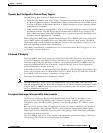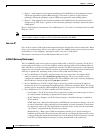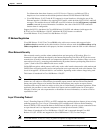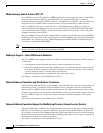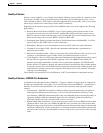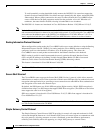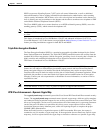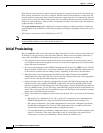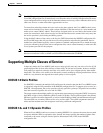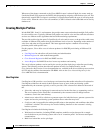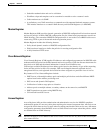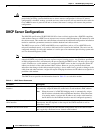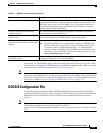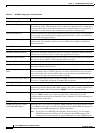
1-15
Cisco uBR924 Software Configuration Guide
OL-0337-05 (8/2002)
Chapter 1 Overview
Supporting Multiple Classes of Service
Note The CMTS typically downloads the DOCSIS configuration file, Cisco IOS image (if needed), and
Cisco IOS configuration file (if needed) only once when the router is initially brought online. However,
a new configuration file or image can be downloaded whenever necessary, such as when the cable service
offers new services or when subscribers upgrade their services.
To ensure that subscribers obtain the exact services they have ordered, the Cisco uBR924 cable access
router arrives from the Cisco factory with a unique identifier (UID) that consists of a serial number and
media access control (MAC) address. These factory-assigned values are on a label at the bottom of the
router; for convenience, these values are also in a barcode label that can be scanned in for easy entry into
the service provider’s provisioning and billing system.
Using the MAC address of the router as the key, the CMTS downloads the DOCSIS configuration file
and Cisco IOS image that will provide the services this particular subscriber has purchased. Service
technicians at the headend typically create a number of standard configuration files to match the range
of services offered by the provider; these configuration files can be created manually or with tools that
Cisco Systems provides for this purpose.
Note For a more detailed description of the provisioning process, see the Cisco uBR924 Cable Access Router
Hardware Installation Guide, available on CCO and the Documentation CD-ROM.
Supporting Multiple Classes of Service
In data-only mode, the Cisco uBR924 cable access router typically uses only one class of service (CoS)
profile that provides for best-effort delivery of data traffic. In data and voice mode, however, multiple
CoS profiles are required so that the real-time voice traffic can be given a higher priority than normal
data traffic. This allows voice traffic to be delivered in a timely manner by delaying transmission of data
traffic in a way that does not degrade the overall quality of service (QoS).
DOCSIS 1.0 Static Profiles
In a DOCSIS 1.0 network, the multiple CoS profiles must be created at the time the Cisco uBR924 router
is registered, using the CoS parameters in the DOCSIS configuration file. To support voice services in a
DOCSIS 1.0 environment, the service provider typically specifies a primary CoS profile for best-effort
data and second CoS profiles for voice and fax traffic.
The router requests the multiple profiles in a registration request message sent to the CMTS. In response,
the CMTS assigns a Service Identifier (SID) for each CoS profile. The first SID assigned is the primary
SID that is used for best effort data traffic as well as for the handling of MAC and maintenance messages.
The other SIDs are secondary SIDs used for voice and fax traffic. These SID assignments remain in
effect until the modem resets and reregisters itself using a different configuration.
DOCSIS 1.0+ and 1.1 Dynamic Profiles
When the Cisco uBR924 cable access router is running DOCSIS 1.0+ software, the router does not need
to request additional SIDs at registration time. Instead, the router specifies the number of phone lines
connected to the router, using the Vendor Specific Information Field (VSIF) in the DOCSIS
configuration file.



